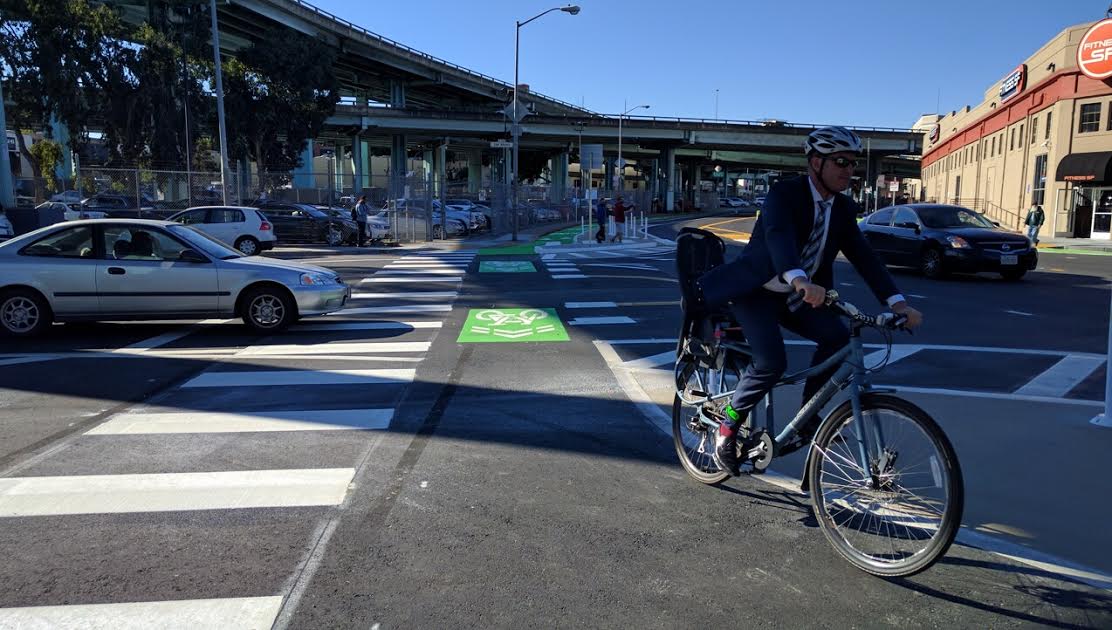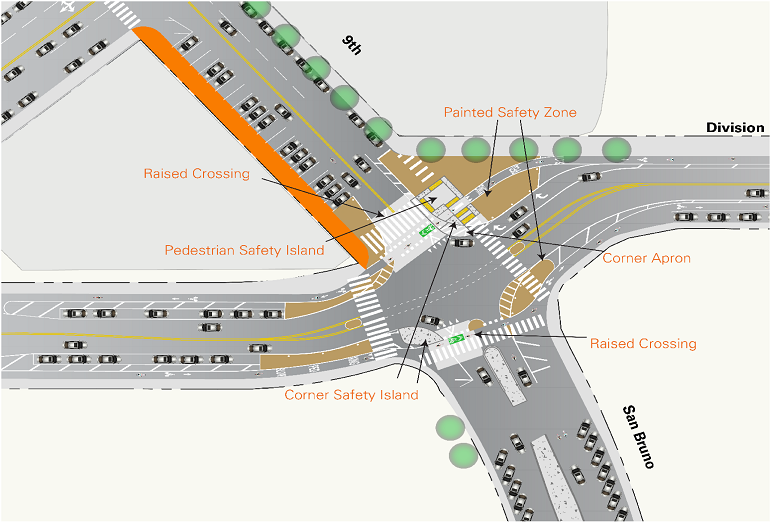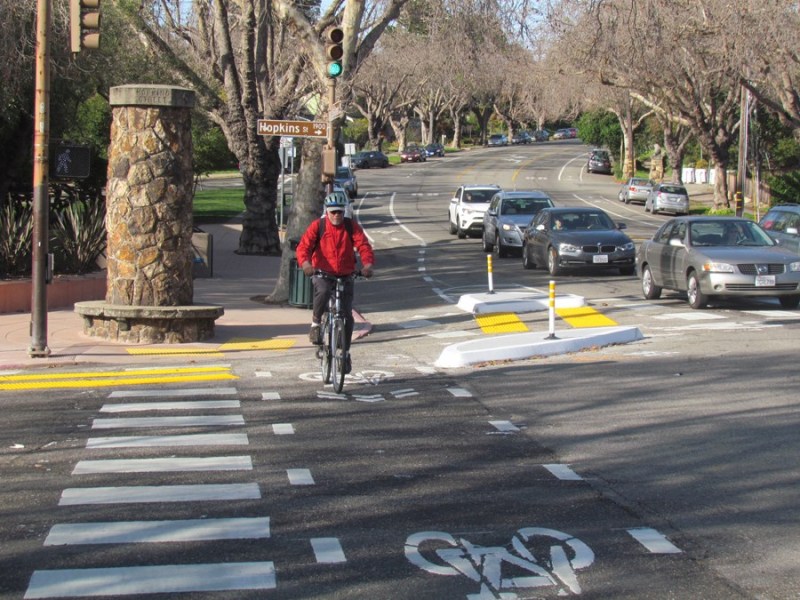Streetsblog got a tour of Oakland’s quick-build protected intersections this week with traffic engineer Teresa Peterson to learn about how the designs were implemented and hear how they’re doing. Streetsblog thought it would be a good excuse to review the protected intersections in other parts of the Bay Area and ask the question again: why do cities keep building stressful ‘mixing zones’ if they’ve got this superior treatment?
Oakland:
Cost: $100,000 per intersection.
Signalized? Yes, without bike phase.
Quick build or permanent installation? Quick Build.
Oakland’s Department of Transportation is gearing up to study driver compliance at the five paint-and-bollard protected intersections and bulb-outs it installed around the Lake Merritt BART station this summer. However, going by early observations, the new treatments seem to be reducing conflicts. “All of these intersections are on our high-injury network for bikes and pedestrians,” said OakDOT’s Peterson. In some cases, “We reduced [pedestrian] crossing distances by 50 to 60 percent.”
This was accomplished in part because the department tracked turning movements by drivers before the finalized designs, and discovered that, for example, on 9th Street so many cars were turning right on Madison (to reach the freeway presumably) that the engineers were able to create forced turn lanes without upsetting traffic flow. Since the cars from that lane don’t travel across the intersection, it allowed them to build huge paint-and-bollard pedestrian bulbouts on the opposite side from the turning pockets, to tighten up crossing distances.

They’ve been tweaking these designs in response to observations and complaints. They had to add bollards to stop confused motorists from occasionally driving down the bike channels (that would also be solved by adding protected bike lanes, which may come as the BART plaza area is further developed). And OakDOT has to figure out a way to rework the turn at 7th and Madison, where car and/or truck drivers keep clipping the turn and wrecking the bollards.
That said, most major design elements seem to be working as planned. From observations, turning speeds are down and conflicts seem relatively rare. Once the study results are in, OakDOT will look at potentially hardening the treatments with concrete curbs.
San Francisco:
Cost: $350,000
Signalized? No.
Quick build or permanent installation? Permanent/concrete.

In 2016, Streetsblog covered the opening of San Francisco’s first protected intersection (well, half a protected intersection, since it doesn’t have protection on the San Bruno side) at 9th and Division. It should be noted that unlike the Oakland example, this intersection is not signalized. SFMTA studied the results in terms of driver compliance and found that 96 percent of drivers approaching a bicyclist yielded where they were supposed to, as did 100 percent of drivers approaching a pedestrian. To put that in perspective, this is a slightly higher rate of compliance than mixing zones with separate bike-phase signals.

“We need to see more complete protected intersections designed and built along high-injury corridors throughout San Francisco for the health and safety of everyone who walks, bikes and drives,” said Brian Wiedenmeier, executive director of the SF Bicycle Coalition, in a post about the project. “With streets like Geneva Avenue and Folsom Street undergoing major redesigns, protected intersections should be considered there and wherever possible in the City’s ongoing efforts to deliver safe streets.”
Berkeley:
Cost: $180,000 (source)
Signalized? Yes, without bike phase.
Quick build or permanent installation? Permanent/concrete.

In the winter of 2016, Berkeley opened its first protected intersection, at Hopkins and The Alameda. According to Berkeleyside, between 2005 and 2010, five pedestrians and a bicyclist were hit by motorists as they crossed this intersection, considered one of the most dangerous crossings in Berkeley. A study from Fehr & Peers shows turning speeds are down and safety is improved. Streetsblog has a request out to the city of Berkeley to find out if they’ve had any crashes since the new installation went in.
Bike East Bay shot this short video of a cyclists traversing this intersection.
“Woo-hoo” indeed.
Meanwhile, Walk Bike Berkeley’s Ben Gerhardstein told Streetsblog he likes the treatment, and thinks it made more sense than just building pedestrian bulb-outs, which was the original intent at this intersection. However, safety has to be part of a system, and without protected bike lanes to accompany the protected intersection, he’s got his doubts. “Bottom line – we need a low stress bike and ped network, not just low-stress intersections,” he concluded.
***
(There are also some Oakland-style, paint-and-post protected bike intersections in San Jose, but we’ll check them out separately in a future post.)
The San Francisco Bicycle Coalition, meanwhile, is a big fan of all of these installations, writing that they take the chaos out of crossing a street, give biking and walking priority, and make everyone slow down, making intersections far more safe. As Streetsblog USA points out, a handful of other cities in North America now have protected intersections in place. The first one was debuted in Davis back in 2015. And of course there’s a mountain of evidence from the Netherlands that they work.
It’s now generally accepted that protected bike lanes are the gold-standard for safe streets. But when it comes to intersections, Oakland, San Francisco, and other cities do these local pilots, but then continue implementing high-stress “mixing zones” in new projects.
When will protected intersections (or protected roundabouts) become the go-to standard? Let us know your thoughts below. And tell us about your experiences riding and walking through protected intersections in the Bay Area and elsewhere.






